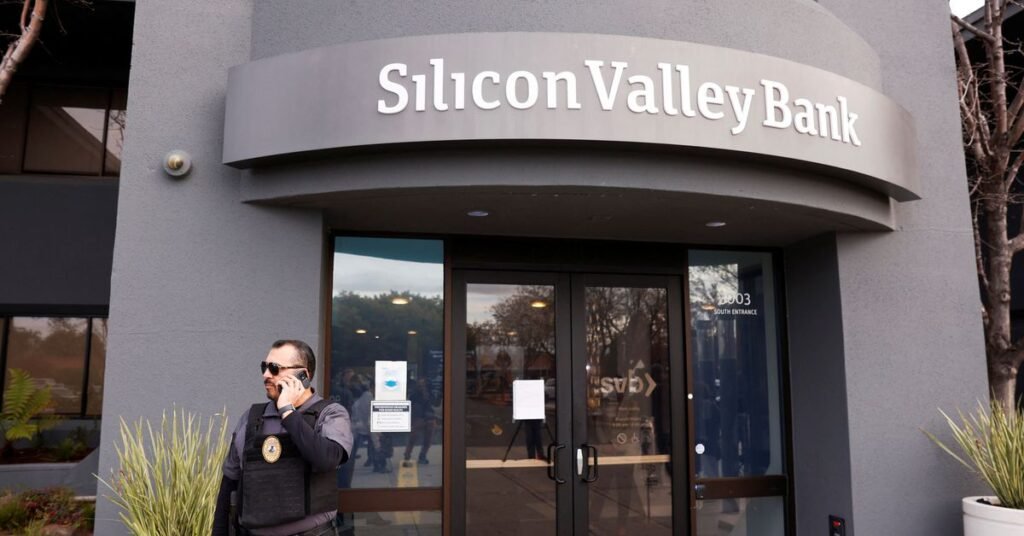April 28 (Reuters) – U.S. regulators on Friday put massive banks on discover that harder oversight is coming, after the Federal Reserve and Federal Deposit Insurance coverage Company detailed their supervisory lapses earlier than deposit runs induced the collapse of Silicon Valley Financial institution and Signature Financial institution in March.
Although the banking sector broadly has since stabilized, the far-reaching affect of the failures of these two massive regional banks was felt on Friday as a fair bigger lender, First Republic Financial institution (FRC.N), teetered on the point of collapse.
Regulators had been getting ready to close San Francisco-based First Republic, an individual accustomed to the matter instructed Reuters. Depositors had pulled $100 billion from accounts on the financial institution within the panic triggered by the SVB and Signature failures, imperiling its survival.
The Fed's evaluation of its inadequacies in figuring out issues and pushing for fixes at Santa Clara, California-based SVB got here with guarantees for harder supervision and stricter guidelines for banks.
“Our first space of focus will probably be to enhance the velocity, drive, and agility of supervision,” Fed Vice Chair of Supervision Michael Barr mentioned in a letter accompanying a 114-page report supplemented by confidential supplies which might be sometimes not made public and which documented rising concern – however little motion – over lax danger administration.
Barr additionally signaled plans to topic banks with greater than $100 billion in belongings to guidelines presently reserved for larger rivals, provided that elevated capital and liquidity necessities would have bolstered SVB's resilience. “Our expertise following SVB's failure demonstrated that it's acceptable to have stronger requirements apply to a broader set of companies.”
Individually, the FDIC delivered a 63-page account of its failings within the collapse of Signature, and people of the New York-based lender's administration, to repair persistent weaknesses in liquidity danger administration and over-reliance on uninsured deposits. Each SVB and Signature failed final month.
“Looking back, the FDIC might have acted sooner and extra forcefully to compel the financial institution's administration and its board to deal with these deficiencies extra shortly and extra totally,” it mentioned.
Each stories mentioned the banks' managers had been primarily guilty for prioritizing progress and ignoring primary dangers that set the stage for the failures.
And whereas they each recognized supervisory misjudgments – the Fed's report was significantly scathing – each stopped in need of laying the accountability for the failures on the ft of any particular senior leaders inside their oversight ranks.
The FDIC did level to Signature's ex-CEO Joseph DePaolo, although not by title, as having personally “rejected” examiner considerations about uninsured depositors on March 10, the day of the financial institution's crippling run. Former SVB CEO Greg Becker was talked about solely as soon as within the Fed's report – in reference to his having additionally been on the board of administrators on the San Francisco Fed.
REACTION
Earlier than the dual failures in March, banking regulators had targeted most of their firepower on the very greatest U.S. banks that had been seen as crucial to monetary stability.
On the Fed that was partially because of new central financial institution “tailoring” laws written in 2018 beneath Barr's predecessor, Randal Quarles, the report mentioned, and to a shift in expectations for supervisors to build up extra proof earlier than contemplating taking motion. Fed workers mentioned they felt stress throughout this era to cut back burdens on companies and display due course of, in accordance with the report.

Quarles didn't instantly reply to a request for remark.
The shortage of forceful examiner motion was a “clear failure of supervisory tradition,” mentioned Senator Tim Scott, the highest Republican on the Senate Banking Committee. Scott, a possible U.S. presidential candidate in 2024, pushed again on re-imposing stricter guidelines that he mentioned would punish well-run banks for the “distinctive” issues of their failed opponents.
Trade did as nicely.
“The Federal Reserve's report lays blame at adjustments to regulation and supervision made lately, when its personal examination supplies make plain the basic misjudgments made by its examination groups over that very same interval,” Greg Baer, the president and CEO of the Financial institution Coverage Institute, mentioned in an announcement.
Nonetheless, any adjustments would give banks loads of time to regulate, famous Eric Compton, a banking analyst at Morningstar. “I feel many buyers had been nervous concerning the regulators dropping the hammer on the entire banking trade, shortly.”
‘POOR MANAGEMENT'
At SVB, the Fed mentioned, supervisors didn't absolutely recognize the issues and didn't appropriately escalate sure deficiencies even after they had been recognized.
On the time of its failure, SVB had 31 unaddressed citations on its security and soundness, triple what its friends within the banking sector had, the U.S. central financial institution's report mentioned, together with issues with interest-rate-risk modeling that examiners directed be addressed by June 2023.
Regulators shut SVB on March 10, a day after clients withdrew $42 billion and queued requests for an additional $100 billion the next morning.
The Fed is contemplating forcing higher compliance from administration by tying immediate fixes to govt compensation, a senior Fed official indicated on Friday.
Each SVB and Signature grew shortly lately, outpacing the power of regulators to maintain up, particularly with shrinking assets.
Between 2016 and 2022, as belongings within the banking sector grew 37%, the Fed's supervision headcount declined by 3%, in accordance with the report.
With reference to Signature since 2020, a median of 40% of positions within the FDIC's massive financial institution supervisory workers within the New York area had been vacant or crammed by short-term workers, the FDIC report mentioned.
Signature's failure, the FDIC mentioned in its report, was brought on by “poor administration” and a pursuit of “fast, unrestrained progress” with little regard for danger administration.
Regulators closed Signature two days after SVB was shuttered. Signature misplaced 20% of its complete deposits in a matter of hours on the day that SVB failed, FDIC Chair Martin Gruenberg has mentioned.
Reporting by Ann Saphir
Modifying by Chris Reese
: .

